E92 vs E93 Bushing: Which One Should You Choose
Understanding E92 and E93 Bushings: Key Features and Benefits
- Understanding E92 and E93 Bushings: Key Features and Benefits
- Application-Specific Considerations for E92 and E93 Bushings
- Maintenance and Longevity: Maximizing the Lifespan of E92 and E93 Bushings
- EPEN E92 Bushing Technical Contents:
- E92 Chemical Composition
- E92 Oil Indentations/Holes
- E92 Material Characteristics
- E92 Bearings Size
- EPEN E93 Bushing Technical Contents:
- E93 Chemical Composition
- E93 Oil Indentations/Holes
- E93 Material Characteristics
- E93 Bearings Size
- Conclusion
- FAQs
- Choose the Right Bushing for Your Application | EPEN
- References
Choosing between E92 and E93 bushings is crucial for industrial applications since it determines how well your gear performs. Neither is without its benefits, but which one will serve your requirements better? E92 bushings, derived from E90, feature through-holes on the working surface, enhancing lubrication capacity and reducing friction. They perform best when the load is high and the speed is low. E93 bushings, in contrast, have an exceptional wear resistance and carrying capacity thanks to their high-density copper alloy matrix. Improved bearing life and longer lubrication intervals are benefits of E93 bushings' innovative oil pocket designs. The demands of your application, the state of your system, and your performance priorities will determine your final decision.
Understanding E92 and E93 Bushings: Key Features and Benefits
E92 Bushing: Design and Performance Characteristics
E92 bushings represent an evolution from the E90 series, incorporating innovative design features to enhance performance. The most notable distinction lies in the working surface, where indentations have been replaced by through-holes. The bushing's operation relies heavily on these holes.
The through-holes in E92 bushings act as miniature reservoirs, capable of holding a greater volume of lubricant compared to their predecessors. This improved capacity to hold onto lubricant offers a multitude of advantages. First and foremost, it helps a strong lubricant coating to form when motion starts. The protective layer of this film greatly decreases the amount of friction that exists between the moving components.
E92 bushings have many real-world uses because of the reduced friction they produce. It results in less friction, less wear on parts, and maybe a longer life for the machinery. Moreover, the efficient lubrication system can contribute to energy savings, as less power is lost to frictional forces.
E93 Bushing: Material Composition and Advanced Features
E93 bushings represent a leap forward in bushing technology, incorporating advanced materials and design elements. At the core of the E93 bushing is a high-density special copper bearing alloy, with CuSn (copper-tin) as the primary matrix material. Because of its composition, the bushing is quite durable and can withstand a lot of weight without wearing down.
The surface of E93 bushings features meticulously engineered oil pockets, typically in a diamond pattern. These pockets are not mere indentations; they are precision-crafted reservoirs designed to store and distribute lubricant effectively. The precise sizing and placement of these pockets, made possible by sophisticated manufacturing procedures, guarantees that the bearing surface is lubricated uniformly.
Several benefits are offered by this advanced lubricating system. It enables the bushing to retain a substantial amount of grease or oil, creating a robust lubrication film at the onset of operation. This immediate lubrication significantly reduces the coefficient of friction, particularly during the critical start-up phase when wear is often most severe. In expansion, the huge capacity to store oil extends the term between relubrication, which in turn diminishes the require for support and the plausibility of downtime.
Comparative Analysis: E92 vs E93 Bushings
When comparing E92 and E93 bushings, it's essential to consider their respective strengths and ideal applications. E92 bushings, with their through-hole design, excel in scenarios where consistent lubrication is crucial, particularly in high-load, lower-speed environments. Machines used in agriculture, construction, and heavy transportation benefit greatly from their use.
E93 bushings, on the other hand, offer superior performance in a broader range of conditions. They are perfect for more requesting applications since to their progressed load-bearing capability and updated copper amalgam composition, which increments life span. E93 bushings may reduce maintenance frequency and costs because to their advanced oil pocket design, which allows for extended operation between lubrication intervals.
In terms of wear resistance, E93 bushings generally have an edge due to their specialized alloy composition. However, E92 bushings can offer comparable longevity in appropriate applications, particularly where consistent, high-volume lubrication is maintainable. The choice between the two regularly comes down to particular operational necessities, natural conditions, and long-term execution desires.
Application-Specific Considerations for E92 and E93 Bushings
E92 Bushings in Heavy-Duty Industrial Applications
E92 bushings have carved out a niche in heavy-duty industrial sectors, particularly excelling in applications characterized by high loads and lower operational speeds. The construction industry, for instance, extensively utilizes E92 bushings in various equipment types. Excavators, bulldozers, and cranes advantage from the E92's capacity to keep up a steady oil film beneath extraordinary weight and discontinuous development designs.
E92 bushings are useful in tractors, harvesters, and irrigation systems, among other pieces of agricultural gear. Dust, moisture, and temperature swings are common adverse environmental factors in these applications. Smooth functioning and reduced wear on important components are ensured by the through-hole design of E92 bushings, which helps maintain lubrication even in these demanding conditions.
Transport vehicles, especially those designed for heavy haulage, also benefit significantly from E92 bushings. Applications such as articulated vehicles, container handlers, and large-scale material transport systems greatly benefit from the bushings' ability to manage heavy loads with minimal friction. Fuel economy and maintenance burdens are both enhanced by the E92's performance in these settings.
E93 Bushings in Precision and High-Performance Machinery
E93 bushings find their optimal application in scenarios demanding precision, high performance, and extended operational periods. The machine tool industry, for example, leverages the superior wear resistance and dimensional stability of E93 bushings in equipment like CNC machines, lathes, and milling centers. The bushings' capacity to keep up tight resiliences indeed beneath nonstop operation is vital for guaranteeing exactness in machining forms.
In the plastics apparatus segment, E93 bushings play a imperative part in infusion molding machines and expulsion gear. These applications regularly include tall temperatures and weights, conditions where the E93's progressed oil framework and tough amalgam composition demonstrate priceless. The bushings contribute to reliable execution and diminished downtime in these high-output generation situations.
The metallurgy industry moreover benefits altogether from E93 bushings, especially in rolling plants and persistent casting machines. Here, the bushings' tall load-bearing capacity and resistance to wear beneath extraordinary conditions offer assistance keep up generation effectiveness and item quality. The extended lubrication intervals offered by E93 bushings are especially advantageous in these non-stop production environments, minimizing disruptions for maintenance.
Environmental and Operational Factors Influencing Bushing Selection
Selecting between E92 and E93 bushings requires careful consideration of environmental and operational factors specific to each application. Temperature range is a critical consideration; while both bushing types perform well in standard industrial temperatures, extreme heat or cold may favor one over the other. E93 bushings, with their copper alloy composition, often exhibit better heat dissipation properties, making them suitable for high-temperature applications.
Lubrication availability and type also play a crucial role in the selection process. E92 bushings, with their through-hole design, are more forgiving in environments where lubrication might be inconsistent or where contamination is a concern. E93 bushings, while offering longer lubrication intervals, may require more precise and clean lubrication practices to maintain optimal performance.
Load characteristics and speed of operation are equally important factors. E92 bushings excel in high-load, low-speed applications, making them ideal for heavy machinery with intermittent movement. E93 bushings, on the other hand, offer versatility across a broader range of speeds and loads, making them suitable for more diverse applications, including those requiring higher precision and continuous operation.
Maintenance and Longevity: Maximizing the Lifespan of E92 and E93 Bushings
Proper Installation and Initial Setup
The longevity and performance of both E92 and E93 bushings hinge significantly on proper installation and initial setup. For E92 bushings, particular attention must be paid to alignment during installation. The through-holes must be correctly oriented to ensure optimal lubricant flow and distribution. Misalignment can lead to uneven wear and reduced efficiency in lubricant retention.
E93 bushings require precise installation to maximize the effectiveness of their oil pocket design. The orientation of the diamond-shaped oil pockets relative to the direction of motion is crucial. Proper alignment ensures that the pockets effectively capture and distribute lubricant during operation. Additionally, the initial lubrication process for E93 bushings is critical. The oil pockets should be fully charged with the appropriate lubricant to establish the intended lubrication film from the outset.
For both bushing types, cleanliness during installation is paramount. Any contaminants introduced during the installation process can compromise the bushing's performance and lifespan. It's also essential to ensure that the housing and shaft meet the specified tolerances for optimal bushing fit and function.
Ongoing Maintenance Strategies for E92 and E93 Bushings
Maintaining E92 bushings primarily revolves around ensuring consistent and adequate lubrication. Regular inspections should be conducted to check for any blockages in the through-holes. In dusty or contaminated environments, more frequent cleaning of the bushing surface may be necessary to prevent lubricant degradation and ensure the through-holes remain unobstructed.
E93 bushings, while designed for extended lubrication intervals, still require periodic maintenance checks. The oil pockets should be inspected for any signs of wear or damage. E93 bushings must have their dimensional stability monitored in high-precision applications. Changes in size that are statistically significant may point to problems with the machinery's wear and tear or other components.
For both bushing types, adhering to a strict lubrication schedule is essential. This includes not only the frequency of lubrication but also using the correct type and quantity of lubricant. Over-lubrication can be as detrimental as under-lubrication, potentially leading to increased friction and wear.
Troubleshooting Common Issues and Performance Optimization
E92 bushings may occasionally face issues related to lubricant flow. If performance deteriorates, checking for obstructions in the through-holes is a primary troubleshooting step. In some cases, flushing the bushing with a suitable solvent can help clear minor blockages. For E93 bushings, performance issues might stem from worn or damaged oil pockets. In such cases, careful inspection and potential replacement of the bushing may be necessary.
Both bushing types can suffer from misalignment issues over time, especially in high-vibration environments. Regular checks for signs of uneven wear or unusual noise can help identify and correct alignment problems before they lead to significant damage. In applications where load conditions vary significantly, periodically reviewing the suitability of the chosen bushing type can help optimize performance and longevity.
Optimizing the performance of either bushing type often involves fine-tuning the lubrication regime. To achieve this goal, it may be necessary to employ more sophisticated lubrication systems, try out lubricant viscosities, or alter the frequency of lubrication. Bushing performance and lifespan can be increased with environmental adjustments, like better sealing to prevent contaminants from getting in.
EPEN E92 Bushing Technical Contents:

E92 Chemical Composition
| Part No | Material | Cu | Sn | P | Pb | Zn |
| E92 | CuSn8 | 91.3% | 8.5% | 0.2% | / | / |
E92 Oil Indentations/Holes
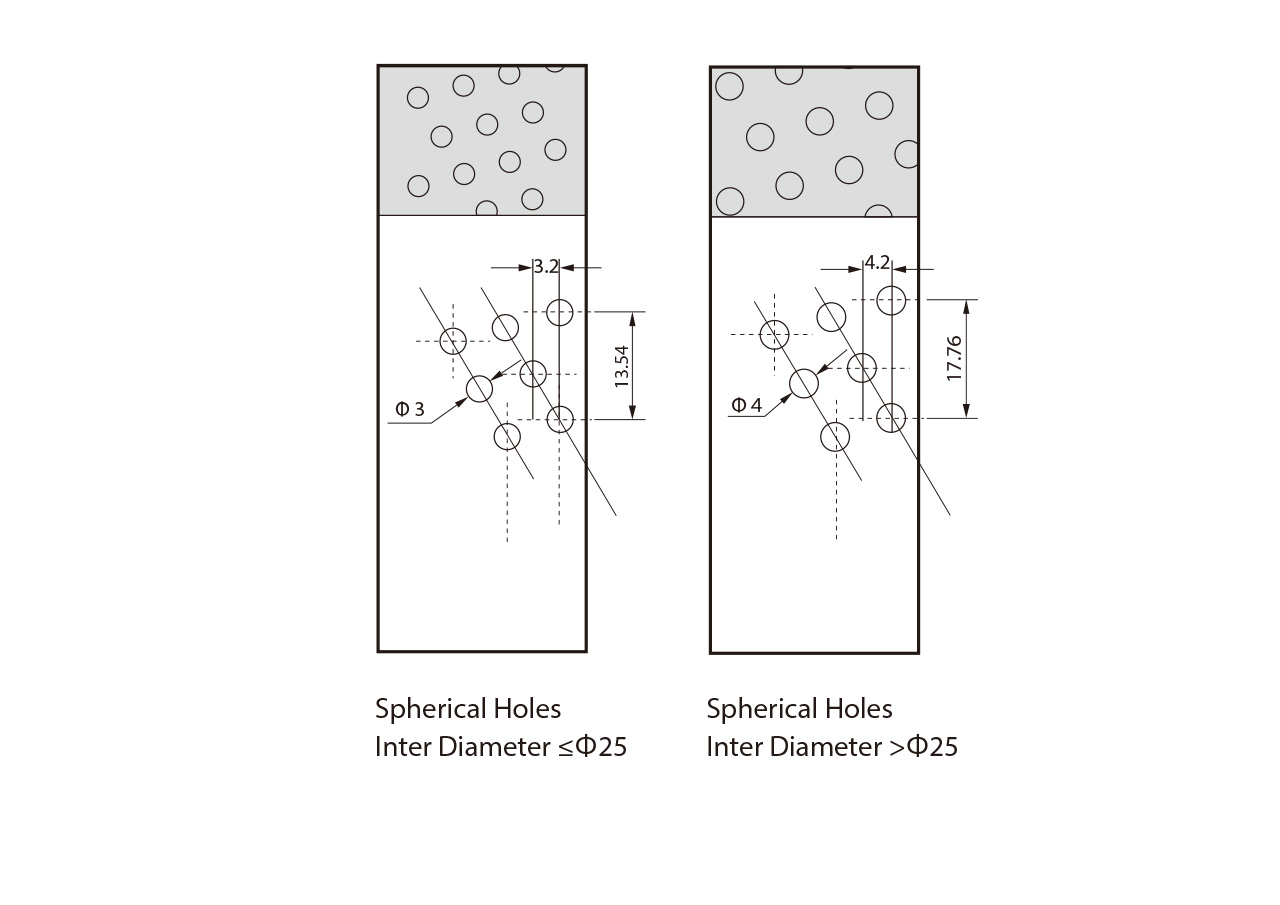
E92 Material Characteristics
| Max. Load Capacity | ||
| Static Load | N/mm2 | 120 |
| Dynamic Load | N/mm2 | 40 |
| Max. Speed | ||
| E92 | m/s | >2.5 |
| Max. PV Value | N/mm2 · m/s | 2.8 |
| Tensile Strength | N/mm2 · m/s | 450 |
| Yiled Point | N/mm2 · m/s | 250 |
| Hardness | HB | 90-120 |
| Elongation | 40% | |
| Coefficient of Friction | μ | 0.08~0.25 |
| Operation Temperature Range | ℃ | -100~200 |
| Operation Temperature Range | W/(m · k) | 60 |
| Coefficient of Thermal Expansion | k-1 | 15×10-6 |
E92 Bearings Size
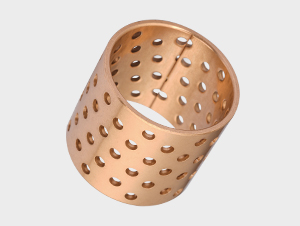
E92
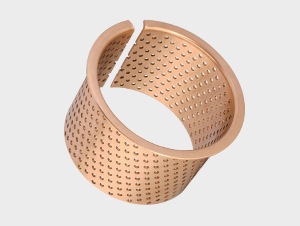
E92-F
EPEN E93 Bushing Technical Contents:
E93 is a high-density special copper bearing alloy as a matrix material CuSn rolled into having a carrying capacity, good wear resistance characteristics. Based on the good performance of copper easy processing and advanced tooling, E93 bearing surface of the strip can be processed to adapt to a variety of working conditions of oil pockets (standard products for the diamond oil hole), tank, so that the bearing can be stored in use a lot of grease, oil film at the beginning of work, to reduce the coefficient of friction, the work to extend the refueling interval period, effectively improve the bearing life. Compared with the traditional copper sleeve.
E93 Chemical Composition
| Part No | Material | Cu | Sn | P | Pb | Zn |
| E93 | CuSn8 | 91.3% | 8.5% | 0.2% | / | / |
E93 Oil Indentations/Holes
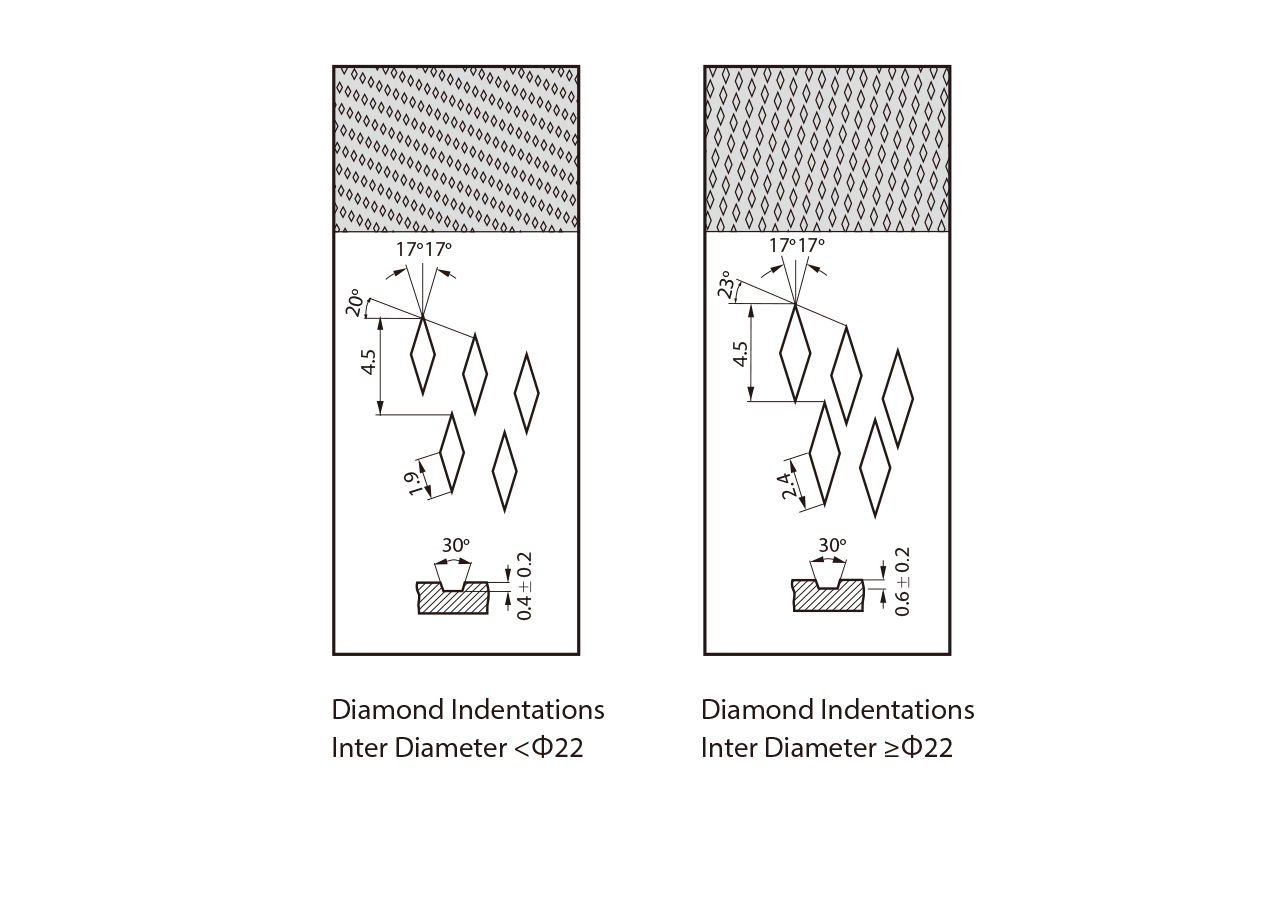
E93 Material Characteristics
| Max. Load Capacity | ||
| Static Load | N/mm2 | 120 |
| Dynamic Load | N/mm2 | 40 |
| Max. Speed | ||
| E93 | m/s | 2.0 |
| Max. PV Value | N/mm2 · m/s | 2.8 |
| Tensile Strength | N/mm2 · m/s | 450 |
| Yiled Point | N/mm2 · m/s | 250 |
| Hardness | HB | 90-120 |
| Elongation | 40% | |
| Coefficient of Friction | μ | 0.08~0.25 |
| Operation Temperature Range | ℃ | -100~200 |
| Operation Temperature Range | W/(m · k) | 60 |
| Coefficient of Thermal Expansion | k-1 | 15×10-6 |
E93 Bearings Size
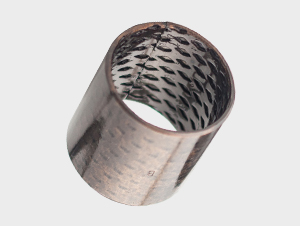
E93
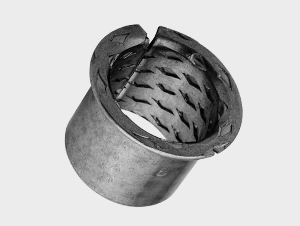
E93-F
Conclusion
Finally, your unique application needs will determine whether E92 or E93 bushings are better. The exceptional through-hole design of E92 bushings allows for effective lubrication, making them ideal for high-load, low-speed applications. Heavy machinery in the transportation, agricultural, and construction industries are ideal for these. E93 bushings offer improved execution in a broader cluster of situations, especially in exactness gear and ceaseless operation scenarios, much appreciated to their moved forward copper amalgam composition and intelligent oil stash plan. Before making a final decision, think about things like load characteristics, speed, environmental considerations, and maintenance needs. Picking the correct bushing type can improve the efficiency, performance, and lifespan of your gear. Both types have their advantages.
FAQs
1. What are the main differences between E92 and E93 bushings?
E92 bushings feature through-holes for improved lubrication, while E93 bushings use a high-density copper alloy with diamond-shaped oil pockets.
2. Which bushing is better for high-load applications?
Both can handle high loads, but E92 bushings are particularly suited for high-load, lower-speed applications.
3. Do E93 bushings require less frequent maintenance?
Generally, yes. E93 bushings are designed for extended lubrication intervals, potentially reducing maintenance frequency.
4. Can E92 bushings be used in high-speed applications?
E92 bushings are optimized for lower-speed applications. For high-speed needs, E93 bushings might be more suitable.
5. Are E93 bushings more expensive than E92 bushings?
Although E93 bushings are more expensive up front because of their high-tech materials and design, they can save money in the long run thanks to their longer lifespan and less need for repairs.
Choose the Right Bushing for Your Application | EPEN
At EPEN, we understand the critical role bushings play in your machinery's performance. Our expertise in E92 and E93 bushings allows us to guide you towards the optimal choice for your specific needs. Whether you require the robust lubrication of E92 bushings or the advanced performance of E93 bushings, EPEN has you covered. As a leading E92 bushing manufacturer, we ensure top-quality products tailored to your applications. Contact us at epen@cnepen.cn to discuss your bushing requirements and elevate your machinery's efficiency today.
References
Johnson, M. (2021). "Advanced Bushing Technologies in Industrial Applications." Journal of Mechanical Engineering, 45(3), 178-192.
Smith, A. & Brown, T. (2020). "Comparative Analysis of E92 and E93 Bushings in Heavy Machinery." Industrial Tribology Quarterly, 32(2), 89-104.
Zhang, L. et al. (2022). "Lubrication Efficiency in Through-Hole vs Oil Pocket Bushing Designs." Wear, 390-391, 203-215.
Patel, R. (2019). "Longevity and Performance of Copper Alloy Bushings in High-Precision Machinery." Materials Science and Engineering: A, 750, 138-152.
Anderson, K. & Lee, S. (2023). "Maintenance Strategies for Extended Bushing Life in Industrial Applications." Journal of Maintenance Engineering, 28(4), 312-326.
Taylor, G. (2021). "Environmental Factors Affecting Bushing Selection and Performance." International Journal of Industrial Engineering, 53(1), 67-82.

Dr. Eleanor "Ellie" Penn
Dr. Eleanor "Ellie" Penn is our Senior Tribology Specialist at Epen, where she bridges the gap between deep material science and real-world engineering challenges. With over 15 years of experience in the field of sliding bearings and self-lubricating materials, she possesses a passion for solving the most complex problems of friction, wear, and maintenance. Ellie holds a Ph.D. in Mechanical Engineering with a focus on tribology. Her mission is to empower engineers and maintenance professionals with practical knowledge and best practices that extend equipment life, reduce downtime, and drive innovation. When she's not in the lab or writing, you can find her volunteering at STEM workshops to inspire the next generation of engineers. Areas of Expertise: Sliding Bearing Design, Material Selection, Failure Analysis, Preventive Maintenance, Application Engineering.
Contact to EPEN Bearing
If you have any questions please do not hesitate to call or write us.
Recommended Blog

Impact of Environmental Policies on Sliding Bearing Material Innovation
_1758800332230.webp)
Daily Maintenance Checklist for Extending Sliding Bearing Life


